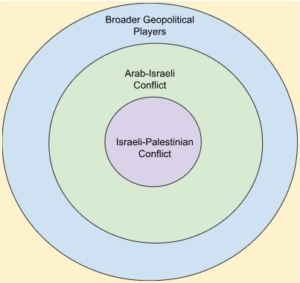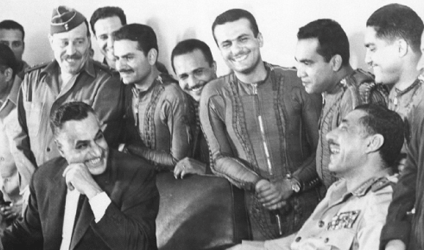Teachers will often ask us why we titled our curriculum “History of the Arab-Israeli Conflict,” as opposed to “Israeli-Palestinian Conflict.” This is a fair question. Before we explain our word choices, let’s first define the two terms:
Arab-Israeli Conflict:
The broad umbrella term for Israel’s historical and current conflicts with the Arab states that have opposed it, including the ongoing conflict with Palestinians.
Israeli-Palestinian Conflict:
The specific conflict related to reconciling sovereignty and boundaries of what is now Israel, the West Bank, and Gaza. The term has also come to refer to the effort to seek solutions that would secure the coexistence of Israelis and Palestinians within those borders.
In other words, the Israeli-Palestinian conflict is part of a larger conflict between Israel and the Arab world. It can be helpful to think about it in terms of concentric circles.

Inner Circle: Israeli-Palestinian Conflict
The parties involved in this conflict are the Israeli government and Palestinian representatives. This includes both the historical and current negotiations and challenges.
Second Circle: Arab-Israeli Conflict
This conflict involves Israel and its neighboring Arab countries, including Egypt, Jordan, Lebanon, and Syria. It includes factors such as historical animosities, regional power struggles, and the influence of pan-Arabism or pan-Islamism.
Third Circle: Broader Geopolitical Players
This conflict has the widest scope, including global powers and influential actors like Iran, Russia, and the United States. Factors of this conflict include strategic interests, alliances, and interventions in the region, and demonstrates how external involvement can either exacerbate or mitigate tensions, shaping the trajectory of the Israeli-Palestinian conflict.
Origins of the Israeli-Palestinian Conflict
The origins of the modern Israeli-Palestinian conflict (the innermost circle of the diagram) begin with the global rise of nationalism in the 19th century. This is why our “History of the Arab-Israeli Conflict” curriculum starts with the developments of the Jewish nationalist movement (known as Zionism) and the Arab nationalist movement in the late 19th and early 20th centuries.
Once the State of Israel was established in 1948, the conflict shifted from a struggle between Jewish and Arab nationalisms to one between Israel and its neighboring Arab countries. This phase saw a series of military conflicts, including wars in 1948, 1967, and 1973. It was during this period that the Israeli-Palestinian conflict emerged as a distinct conflict within the broader conflict between Israel and Arab nations. Our curriculum follows this historical shift and focuses on the conflict between Israel and the Palestinians through the early 2000s. In order to make it clear that our curriculum covers those broader historical events and forces, we titled our curriculum the way we did.

